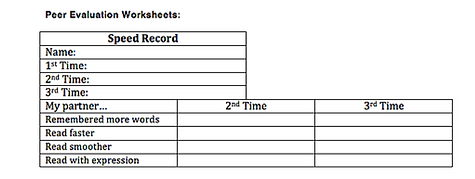
Miss Ehringer's
Reading lessons
Growing Fluency with Ferdinand the Bull

Rationale
This lesson is designed to improve students’ reading fluency. Reading fluently means that nearly all the words a student is reading are a part of their sight vocabulary. As a result, the student can read at a fast and even pace without disturbing their reading comprehension. Fluency also makes it possible for students to read with expression. Before students can reach a level of reading fluency, they must first demonstrate proficiency in decoding words. In this lesson, students will learn the strategies and skills to become fluent readers through the repeated reading of The Story of Ferdinand.
Materials
-
Class set of The Story of Ferdinand
-
A class set of stopwatches
-
Pencils
-
Fluency checklists charts
-
Reading tracker charts (with an image for chart)
-
Exit quizzes
-
Cover-up critter
-
Whiteboard
-
Dry erase markers
Procedures
1. First, the teacher will explain the concept of fluency to the class.
Say: "Today, we are going to learn about what it means to become fluent readers. Does anyone know what it means to be a fluent reader? [After calling on several students, the teacher should explain:] Being a fluent reader means you know all of the words in the story automatically so that you can read quickly and smoothly. While reading, you understand the story and can read with expression, which means we change our voices to fit the story’s events. Today, we are going to practice the skills needed to become fluent readers."
2. Next, the teacher will review skills for decoding and crosschecking.
Say: "Before we look at fluent reading, we need to review our reading skills of decoding and crosschecking. When we come across a word that we don’t know, we have to decode the word. Let’s look at the sentence on the board and review how to decode [have the sentence “We have so much fun together.” written on the board; this is a sentence from the book that students will read in the lesson]. When we are reading this sentence and come across a word we don’t know, we can use our coverup critter to help us decode the word. So, let’s try: If we are reading the word flowers, we can use our coverup critter and cover up all of the letters except for f. /f/…/f/…/f/. Now we can uncover l. /l/…/l/…/l/. So, we have /f//l/. We can get decoding: /f//l//ow//er//s/. “I like it better here where I can just sit quietly and smell the /f//l//ow//er//s/?” Oh! “I like it better here where I can just sit quietly and smell the flowers!” So, when we crosscheck, we can use the sentence and the sounds to identify a word. Fluent readers use these skills to learn words better to read more words automatically and be better, fluent readers."
3. Next, the teacher will model fluent and non-fluent reading.
Say: "Next, we are going to look at the difference between fluent and non-fluent reading. [Have sentence example on the board] If I was reading this sentence: 'He had a favorite spot out in the pasture under a cork tree.' A non-fluent reader would read it something like this: 'He has a f-f-a-v-o-o-r-i-t-t-e spot out in the pasture under a cork tree?' 'OH! He had a favorite spot out in the pasture under a cork tree!' Readers that are not yet fluent might have to decode and crosscheck a few words that they don’t know yet like I had to do. They would also read in a very normal, monotone voice without any expression. When you are reading this way, it is harder to understand the message of the story. Sometimes you have to practice several times before you are fluent. I might reread the sentence and improve, but it still might not be fluent reading: [reread the sentence, still slow and without expression, but this time gets all of the words right]. I got all the words right without decoding, but I am still not reading with expression and am a bit slow. Let’s try again and see if I can read this sentence fluently: [read sentence fluently at an average speed, getting all words correct, and adding expression]. Wow! Now that is fluent reading. It is much easier to understand someone’s reading when they are reading fluently, isn’t it? I’m going to read the sentence fluently one more time, and I want you to tell me why my reading is better than the first two times I read the sentence." [call on students and discuss fluent reading one more time].
4. Next, the teacher will give a book talk and instruct the class on reading silently.
Say: "Now we are going to read a book. This book is called The Story of Ferdinand by Munro Leaf. In this book, we learn about a bull named Ferdinand. Ferdinand is a little bull who is different and not like the other little bulls. He is not reckless and wild. He is very quiet and likes to sit by himself. He does not want to play with the other bulls. What’s going to happen to Ferdinand? Will he make any friends even though he is different? We will have to read to find out. [distribute individual copies of the book to class] We will read this book silently in our seats"—[It is good practice for the teacher to read the text silently to herself as well].
5. After the students read silently, the teacher will then pair them up with partners.
Say: "You and your partner will now get a stopwatch, a copy of The Story of Ferdinand, a reading rate chart, a fluency checklist, and a pencil. You and your partner are each going to read three times, with a total of six reads in all. You will take turns being the reader and being the timer. The timer will time the reading, mark any words that the reader doesn’t know, and record the times on their reading chart. The reader will read the story, trying to become a more fluent reader each time. When it is your job to be the timer, be sure that you hit start as soon as your partner starts to read and hit stop as soon as they are done reading. After your partner has finished reading each time, you should fill out the fluency reading checklist. Filling these charts out will help your partner determine what aspects of their fluency are improving and help them to think about what they need to work on. After each reading, I want you to give your reading partner a unique compliment about how their reading improved. You can complement your partner on their speed, expression, smoothness, or ability to remember the hard words from before, so pay attention to their reading. Before we begin, I will go through how to fill out the chart and show you how the stopwatch works—[Model the use of the chart and stopwatch]. If you have any questions while you are working, just raise your hand. I will be walking around and observing each group as you work."
Fluency Checklist: one will be filled out for each reading partner
6. Everyone should then return to their seats and make sure their fluency charts are complete. The teacher should lead the class in computing their words per minute rate with the formula [words correct x 60/seconds total]. They should jot these rates on their reading tracker chart. When everyone is finished, the teacher will collect all fluency checklists and use them to assess where students stand on fluency. Each student can keep their reading tracker chart so that they can continue to work towards their goal.
Reading Tracker:
0 - - - - 10 - - - - 20 - - - - 30 - - - - 40 - - - - 50 - - - - 60 - - - - 70 - - - - 80 - - - - 90 - - - - 100
Correct Words Per Minute:
7. Finally, the students will take a reading comprehension exit quiz about the book to measure their comprehension of their reading.
Comprehension Quiz
-
What are some words used to describe Ferdinand?
-
Where is Ferdinand’s favorite place?
-
Why was Ferdinand’s mother worried about him?
References
Attia, Andie. Flying to Fluency. https://aka0029.wixsite.com/lessondesigns/growing-independence-and-fluency
Chambliss, Miranda. Making Friends with Fluency
https://mkc0040.wixsite.com/mirandachambliss/growing-fluency-design
Leaf, Munro. The Story of Ferdinand. United Kingdom, Penguin Young Readers Group, 2018.
https://www.google.com/books/edition/The_Story_of_Ferdinand/wj9wDwAAQBAJ?hl=en&gbpv=0
Images for Reading Tracker:
https://medium.com/@paysonschwin/raising-ferdinands-3fb2da788d00
Cover-up Critters:
http://www.auburn.edu/academic/education/reading_genie/materials.html
